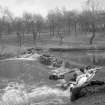Glasgow, Kelvingrove Park, Clayslaps Mills
Sluice (Medieval), Steam Engine (19th Century) - (Late 19th Century) (1814)-(1874), Watermill (Early 16th Century) - (Late 19th Century)-(1874), Weir (Medieval)
Site Name Glasgow, Kelvingrove Park, Clayslaps Mills
Classification Sluice (Medieval), Steam Engine (19th Century) - (Late 19th Century) (1814)-(1874), Watermill (Early 16th Century) - (Late 19th Century)-(1874), Weir (Medieval)
Alternative Name(s) River Kelvin; Corporation Of Bakers, Glasgow
Canmore ID 211163
Site Number NS56NE 2902
NGR NS 56899 66341
Datum OSGB36 - NGR
Permalink http://canmore.org.uk/site/211163
- Council Glasgow, City Of
- Parish Glasgow (City Of Glasgow)
- Former Region Strathclyde
- Former District City Of Glasgow
- Former County Lanarkshire
NS56NE 2902 56899 66341
Not to be confused with NS56NE 4876.
Weir [NAT] (at NS 5690 6633)
Sluice [NAT] (at NS 5688 6633)
OS 1:1250 map, 1971.
Weir, Clayslaps Mills, Kelvingrove Park. A simple, low masonry weir, with the site of a low breast wheel. All traces of the mill buldings have disappeared.
J R Hume 1974.
This weir and sluice cross the River Kelvin to the E of Kelvingrove Museum (NS56NE 329), and within the area of Kelvingrove Park (NS56NE 328). The river here forms the boundary between the parishes of Govan (to the NE) and Glasgow (to the SW).
The NGR assigned to this record defines the centre of the weir. Taken together, these features extend from NS 56880 66335 to NS 56915 66344.
It remains uncertain on which bank the former mill was situated, but the location of the sluice to the W of the weir may suggest that it stood on the Glasgow bank.
Information from RCAHMS (RJCM), 2 December 2005.
Field Visit
NS 5687 6635 Thirty years ago, Clayslaps Dam stood at least 2m high across the River Kelvin. Since then, most of the remaining sandstone blocks (some weighing up to 1000kg) have been dislodged in winter floods and washed downstream, where they lie in a tumble. This destruction has exposed the lowest courses and foundations of the weir and sluices. These comprise a complex layout of dressed sandstone masonry, postholes and cut-outs in the bedrock, from several phases of weirs dating back to the medieval period. A part of the lower courses of the weir are quarried from the solid bedrock.
The dam is sited on a natural drop in the sandstone river bed. Some upstanding parts of the weir survive on the river banks, beyond the main river flow. An exposed cross section shows that the masonry dam has a timber core, consisting of vertical posts set into the postholes in the bedrock and infill timber panels.
Clayslaps was traditionally known as the ‘New Mill of Partick’. From the early 1500s it had a succession of multiple uses as a grain mill, waulk mill, lint mill, snuff mill and malt grinding mill for Glasgow’s brewers. In 1771 Clayslap Mills were purchased by Glasgow’s Bakers and converted entirely to flour grinding to feed Glasgow’s growing population. This dam powered three undershot water wheels, 5m in diameter, driving 15 pairs of mill stones. The mill buildings latterly filled most of the river bank behind Kelvingrove Museum, from this dam down to Regents Mill Dam. Clayslap Mills were demolished and completely cleared in c1874, but the dam and its sluices were retained and used to manage the high water levels that were required for leisure and boating in Kelvingrove Park, particularly during Glasgow’s International Exhibitions of 1888 and 1901.
Stuart Nisbet
Desk Based Assessment
A 30 horse power, stroke 28 1/8 in by 6 feet, Boulton and Watt sun and planet engine was ordered by Corporation of BAkers, Glasgow in 1800, with additional parts ordered in 1801 and 1814 for the same engine.
Birmingham Library, Boulton and Watt Archive MS/3147/5/209.
Information from Mark Watson, HES, Conservation Directorate, 2 April 2019.








